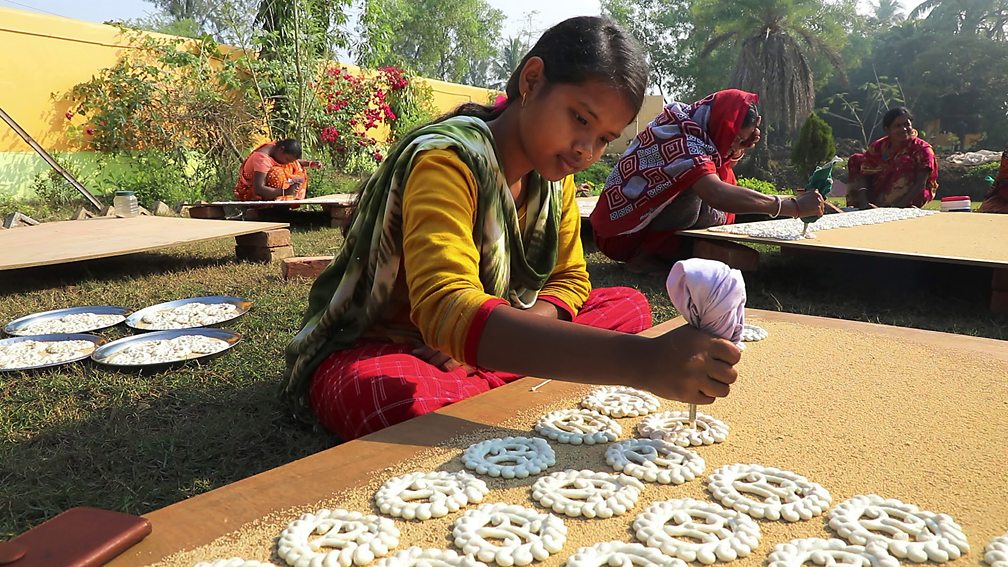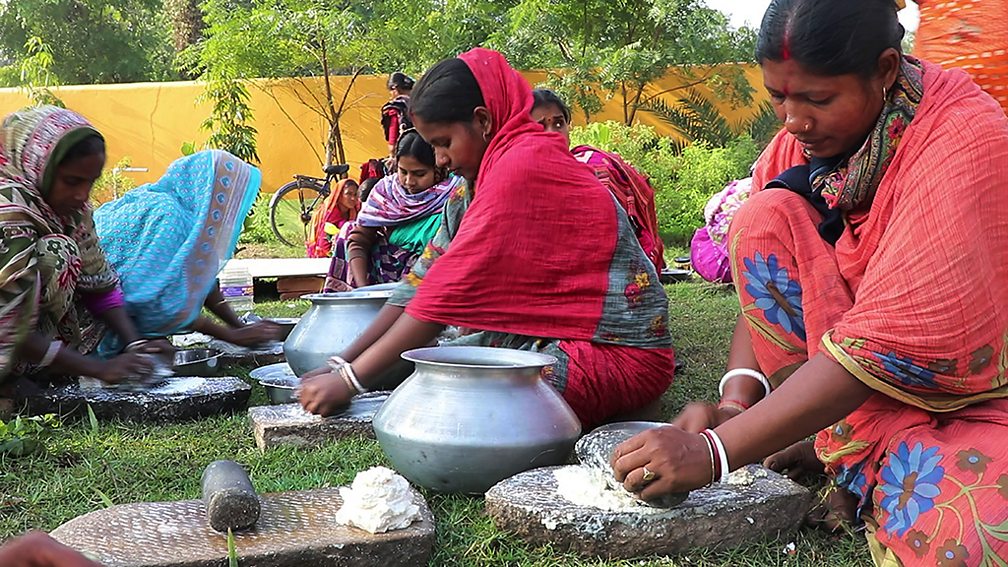By Sugato MukherjeeFeatures correspondent

Gohona bori is a crisp, salty lentil snack that is meticulously hand-crafted and reserved for the most special occasions.
Jyotsna Maity fixed the large, circular brass plate with a meditative gaze. A bed of poppy seeds was neatly and evenly spread over the dish. She began to slowly extrude the lentil batter through the piped cloth bag she had in her right hand, holding it perpendicularly over the platter. Her nimble wrist delicately twisted and turned to form concentric circles, decorative curls and miniscule triangles with the gooey paste. With a sharp, controlled jerk of her hand, she completed the design that now resembled a dainty designer necklace.
Maity was the head of the squad of women similarly occupied on the spacious terrace: their heads bent over brass plates and hands busy to create a culinary artform, the tricks of which have been handed down to them orally through generations.
I was at Chauddhachuli village, located in the East Midnapore district in the eastern Indian state of West Bengal, to witness the ancient art of gohona bori. While bori is a plain lentil dumpling, eaten as a humble accompaniment to lentil soup or added to fish and vegetable dishes to enhance the flavours, gohona bori is a specialty snack that looks like a meticulously designed ornament (gohona in Bengali language means jewellery). Salty with a crunchy twist from poppy seeds, gohona boris are reserved for special occasions as tasty tea-time snacks. They can also be a delightful starter for an elaborate and traditional Bengali meal, with a spoonful of ghee (clarified butter) and eaten with piping hot rice.
"Preparation of gohona boris is a winter activity and largely a gendered practice," said Maity. Usually, starting on a day in mid to late November, village women take an early morning bath, wear fresh clothes and perform a puja – the Hindu ritual of the worship of the divine – before starting the laborious procedure of grinding the tenderised black grams (a South Asian legume also known as urad daal or bean) that have been soaked overnight. To do this, they use a tool called shilnora in Bengali language: a flat mortar and stone pestle.
"We usually need two rounds of manual grinding to get a soft, pasty texture," Maity said. The batter is then whisked by hand until it turns silky smooth and fluffy. Then it is ready to be gently piped over the ultrathin layer of poppy seeds with myriad patterns and motifs of free-flowing finery. One piece at a time.

"Two days of drying them under the warm and mellow winter sun will now lend a perfect balance of crispness and flavour to these gohona boris," Maity said, as her small team of village women inspected the freshly made batch of artisanal treats, shaped like earrings, pendants and tiaras, laid out on the terrace. Once they've dried in the sun, the delicacies are fried in mustard oil until both sides are lightly browned all over.
"Gohona boris used to be a part of the bridal caparison back in the olden days," said Animesh Das, who heads the gohona bori project of Turiyo Foundation, a local organisation focused on entrepreneurial programs for rural communities. The foundation has partnered with Maity and other local women to produce gohona boris in small batches and market them.
"Small-scale is the operative word with this heritage edible art," Maity said. This is because the fine skill set needed to produce gohona boris makes this unsuitable for mass production. The packaging has to be immaculate for the fragile and brittle snacks that have a limited shelf life. "So yes, this has to remain as a handicraft, as it has always been," Das confirmed.
No one is certain when the culinary craft originated, but it was first prepared in the aristocratic households of the East Midnapore district, where the sunny and dry climate is perfect to sun-bake the gohona boris. In 1930, when the Nobel Laureate poet Rabindranath Tagore was presented with a box of gohona boris, he was so intrigued by the exquisiteness of the goodies that he had them photographed and displayed as exhibits at the Kala Bhavana (Department of Fine Arts) in the university town of Shantiniketan, near Kolkata.
"I am not sure when and how the unassuming, no-frills bori transformed itself from a pantry staple to an artisanal snack in East Midnapore district," said Das. Here, he said, it is reserved for special occasions such as the first visit of the son-in-law to the bride's home, or for a get together of long-lost friends and relatives.
Maity and her teammates treat gohona bori not only as an ornamental accompaniment to a festive meal, but as an integral part of a cultural legacy they grew up with. "We organise winter workshops here in Chauddhachuli. However, there is no pre-set blueprint for this edible art," said Maity. "Once you master the craft, your imagination takes over and you can even create newer designs of gohona boris – flowers, birds, or maybe, just simple motifs!"

Gohona bori recipe
By Jyotsna Maity
Makes 10-12 pieces
Ingredients
100-120g (3½-4oz) split black grams
500ml (about 2 cups) water, for soaking the black grams
100g (3½oz) poppy seeds
mustard oil, for deep-frying
Method
Step 1
Thoroughly clean and wash the black grams and soak them overnight in the water to tenderise them.
Step 2
Two rounds of manual grinding with a flat mortar and stone pestle are needed to obtain a soft paste. A food processor or blender can be a good alternative to get the right texture. Once ground to a soft paste, whisk the batter vigorously till the blend turns smooth and consistent. Do not add water, which will spoil the batter.
Step 3
Spread out a thin layer of poppy seeds over a flat platter. Fill a piping bag with the mixture, piling it in slowly to ensure that no air bubbles get into the batter.
Step 4
Start extruding the batter slowly onto the bed of poppy seeds. To have better control over the shape and size of the gohona bori you are trying to make, consider fitting a nozzle with the piping bag.
Step 5
Dry for at least two days under the sun and cool air, then the gohona boris are fry-ready.
Step 6
Deep-fry the gohona boris in oil until lightly browned on both sides. Serve crisp and hot.
BBC.com's World's Table "smashes the kitchen ceiling" by changing the way the world thinks about food, through the past, present and future.
---
Join more than three million BBC Travel fans by liking us on Facebook, or follow us on Twitter and Instagram.
If you liked this story, sign up for The Essential List newsletter – a handpicked selection of features, videos and can't-miss news delivered to your inbox every Friday.
Gohona bori: India's heritage edible ornament - BBC.com
Read More

No comments:
Post a Comment